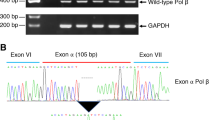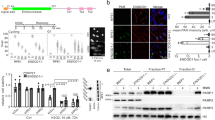Abstract
Poly(ADP-ribose) polymerase (PARP4) catalyzes the formation of ADP-ribose polymers covalently attached to proteins by using NAD+ as substrate. PARP is strongly activated by DNA single- or double-strand breaks and is thought to be involved in cellular responses to DNA damage. We characterized a dominant negative PARP mutant, i.e. the DNA-binding domain of this enzyme, whose overexpression in cells leads to increased genetic instability following DNA damage. In order to study whether PARP activity is also implicated in the process of tumorigenesis, we generated stably transfected HeLa cell clones with constitutive overexpression of dominant negative PARP and investigated tumor formation of these clones in nude mice. We found that inhibition of PARP activity dramatically reduces tumor forming ability of HeLa cells. Moreover, we provide strong evidence that the observed reduction in tumor forming ability is due to increased tumor cell apoptosis in vivo. Viewed together, our data and those from other groups show that inhibition of PARP enzyme activity interferes with DNA base excision repair and leads to increased genetic instability and recombination but, on the other hand, can sensitize cells to apoptotic stimuli and by this mechanism may prevent tumor formation.
This is a preview of subscription content, access via your institution
Access options
Subscribe to this journal
Receive 50 print issues and online access
$259.00 per year
only $5.18 per issue
Buy this article
- Purchase on Springer Link
- Instant access to full article PDF
Prices may be subject to local taxes which are calculated during checkout




Similar content being viewed by others
Abbreviations
- DBD:
-
DNA-binding domain of PARP
- MNNG:
-
N-methyl-N′-nitro-N-nitrosoguanidine
- PARP:
-
poly(ADP-ribose) polymerase
- SV40:
-
simian virus 40
References
Butler AJ and Ordahl CP. . 1999 Mol. Cell. Biol. 19: 296–306.
Jeggo PA. . 1998 Curr. Biol. 8: R49–R51.
Kaufmann SH, Desnoyers S, Ottaviano Y, Davidson NE and Poirier GG. . 1993 Cancer Res. 53: 3976–3985.
Kawamitsu H, Hoshino H, Miwa M and Sugimura T. . 1983 Princess. Takamatsu. Symp. 13: 41–47.
Korsmeyer SJ. . 1995 Trends Genet. 11: 101–105.
Küpper JH, de Murcia G and Bürkle A. . 1990 J. Biol. Chem. 265: 18721–18724.
Küpper JH, Müller M and Bürkle A. . 1996 Cancer Res. 56: 2715–2717.
Küpper JH, Müller M, Jacobson MK, Tatsumi MJ, Coyle DL, Jacobson EL and Bürkle A. . 1995 Mol. Cell. Biol. 15: 3154–3163.
Küpper JH and Müller M. . 1996 Cytotechnology 21: 225–229.
Lamarre D, Talbot B, de Murcia G, Laplante C, Leduc Y, Mazen A and Poirier GG. . 1988 Biochim. Biophys. Acta 950: 147–160.
Lindahl T, Satoh MS, Poirier GG and Klungland A. . 1995 Trends Biochem. Sci. 20: 405–411.
Molinete M, Vermeulen W, Bürkle A, Menissier-de Murcia J, Küpper JH, Hoeijmakers JH and de Murcia G. . 1993 EMBO J. 12: 2109–2117.
Nicholson DW, Ali A, Thornberry NA, Vaillancourt JP, Ding CK, Gallant M, Gareau Y, Griffin PR, Labelle M, Lazebnik YA, Munday NA, Raju SM, Smulson ME, Yamin TT, Yu VL and Miller DK. . 1995 Nature 376: 37–43.
Oei SL, Griesenbeck J, Ziegler M and Schweiger M. . 1998 Biochemistry 37: 1465–1469.
Oliver FJ, de la Rubia G, Rolli V, Ruiz RM, de Murcia G and Menissier-de Murcia J. . 1998 J. Biol. Chem. 273: 33533–33539.
Satoh MS, Poirier GG and Lindahl T. . 1993 J. Biol. Chem. 268: 5480–5487.
Schreiber V, Hunting D, Trucco C, Gowans B, Grunwald D, de Murcia G and Menissier-de Murcia J. . 1995 Proc. Natl. Acad. Sci. USA 92: 4753–4757.
Simbulan RC, Rosenthal DS, Iyer S, Boulares AH and Smulson ME. . 1998 J. Biol. Chem. 273: 13703–13712.
Song Q, Lees MS, Kumar S, Zhang Z, Chan DW, Smith GC, Jackson SP, Alnemri ES, Litwack G, Khanna KK and Lavin MF. . 1996 EMBO J. 15: 3238–3246.
Teraoka H, Yumoto Y, Watanabe F, Tsukada K, Suwa A, Enari M and Nagata S. . 1996 FEBS Lett. 393: 1–6.
Tewari M, Quan LT, O'Rourke K, Desnoyers S, Zeng Z, Beidler DR, Poirier GG, Salvesen GS and Dixit VM. . 1995 Cell 81: 801–809.
van Gool L, Meyer R, Tobiasch E, Cziepluch C, Jauniaux JC, Mincheva A, Lichter P, Poirier GG, Bürkle A and Küpper JH. . 1997 Eur. J. Biochem. 244: 15–20.
Wang ZQ, Stingl L, Morrison C, Jantsch M, Los M, Schulze-Osthoff K and Wagner EF. . 1997 Genes Dev. 11: 2347–2358.
Whitaker JR and Granum PE. . 1980 Anal. Biochem. 109: 156–159.
Acknowledgements
This work was partly supported by a grant from the Dr Mildred-Scheel-Stiftung für Krebsforschung (W25/94/Bü1). We wish to thank Drs Guy G Poirier, Masanao Miwa, Takashi Sugimura and Michael Boshart for reagents, Professor Harald zur Hausen for continuous support, Ms Heike Kürner for excellent technical assistance, and Dr Ralph Meyer for critical reading of the manuscript.
Author information
Authors and Affiliations
Rights and permissions
About this article
Cite this article
Hans, MA., Müller, M., Meyer-Ficca, M. et al. Overexpression of dominant negative PARP interferes with tumor formation of HeLa cells in nude mice: Evidence for increased tumor cell apoptosis in vivo. Oncogene 18, 7010–7015 (1999). https://doi.org/10.1038/sj.onc.1203178
Received:
Revised:
Accepted:
Published:
Issue Date:
DOI: https://doi.org/10.1038/sj.onc.1203178
Keywords
This article is cited by
-
PARP-1 Val762Ala polymorphism is associated with reduced risk of non-Hodgkin lymphoma in Korean males
BMC Medical Genetics (2010)
-
Poly(ADP-ribose) polymerase and the therapeutic effects of its inhibitors
Nature Reviews Drug Discovery (2005)



